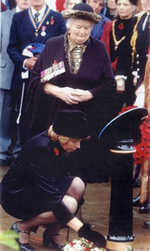
Latest
News
Aims
of the Society
Membership
Past
Journals
Contact
Us
Interesting
Links
Auction Activity
Recommended Reading
Home Page
Events
Collectors Club
Journal Index
Book Offers
|
Sample Journal Articles
CHARLES LUCAS – THE FIRST VC
By Brian Best
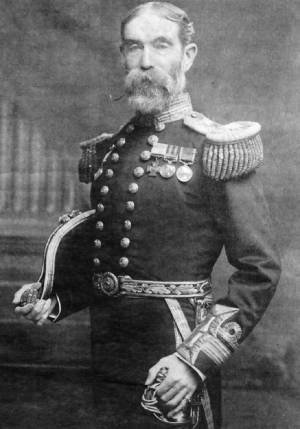
Three men can
claim to be the first VC in that elite list of recipients of the world’s
highest award for outstanding gallantry. The name of Lieutenant Cecil Buckley
RN was the first to be published in the London
Gazette of 24 February, 1857 for his part in two exploits in the Sea of
Azoff
on 28 May, 1855. Due to his superior rank, Commander Henry Raby RN was the
first man to physically receive the Cross at the inaugural investiture on 26
June, 1857. This was awarded for his part in bringing in a wounded soldier
under fire during the abortive attack on the Redan , 18 June, 1855. (see cover
of 4th edition of The Journal)
The man who could genuinely be said to be
the very first VC, however, was a young Irish midshipman named Charles Lucas,
whose gallant act was performed on 20 June 1854, in what was virtually the
first action of the war against Russia.
He was born into a wealthy landowning family on 19 February 1834 at Drumargole,
County
Armagh. At the age of fourteen, he
joined the Navy in 1848, the year of the Irish Potato Famine. He first served
aboard HMS Vanguard, but it was in
his second ship, the 40 gun Fox, that
he saw his first action in the Second Burmese War of 1852.
Under the command of Commadore G.Lambert, Fox was part of the small squadron that
attacked the heavily fortified enemy town of
Martaban to great effect. Led by Commander
Tarleton of the Fox, a landing party
attacked and captured the enemy stockades, spiking their guns and destroying
their ammunition. Further action followed against
Rangoon and Pegu. The end of the war resulted
in the annexation of most of Burma
to the East India Company.
With the outbreak
of war with Russia in 1854,
the greatest naval danger was seen as the Baltic Sea, where Russia’s main fleet and her
principle arsenals were situated. It followed that the main Anglo-French fleet
was sent to the Baltic, but any hope that the Russians would oblige with a set
piece naval battle was thwarted by the enemy’s refusal to leave Kronstadt,
their heavily-defended home port. The monotonous task of operating a blockade
was alleviated by the occasional raid against land targets.
Before war had been declared, the
Admiralty had the foresight to reconnoitre the Baltic area and despatched the
new steam sloop, Hecla. Midshipman, or Mate, Charles Lucas had
recently transferred to the Hecla,
which left Hull
on 19 February 1854. In a voyage of some 3000 miles, she carried a team of
surveyors, who drew charts and sought suitable anchorages for the large
Anglo-French fleet. Several times Hecla
used her superior speed to outrun Russian frigates, for she was better suited
to speed than fighting, something later her captain seemed to forget.
The Hecla’s
captain was the energetic and resourceful William Hutcheson Hall, a man who
would play a prominent role in Lucas’s life. As a young lieutenant, Hall had
commanded the East India Company iron steam ship Nemesis during the First China War of 1840. With its shallow
draught and armed with rockets, the Chinese called it the “devil ship”, as it
created havoc amongst the enemy junks in Anson Bay. Hall further came to the
Lordship’s attention when he, and two other like-minded officers, proposed the
establishment of a sailor’s home in Portsmouth.
When sailors were paid off, they were often far from home and fell easy prey to
all sorts of persons who were skilled in parting the unsuspecting victim from
his money. The idea of a sailor’s hostel gained approval and both Queen
Victoria and Prince Albert
added their endorsement and financial support. From this, there grew the highly
successful establishment, which gave sailor’s a refuge while waiting for
another posting.
When the Hecla returned from her Baltic mission, she joined the main fleet
at Dover. The
surveyors distributed their charts and briefed the commander, Sir Charles
Napier, and his captains. The fleet, including Hecla, then set course for the Baltic.
After the disappointment of the Russian
fleet’s refusal to fight, lesser targets were sought. It was Hecla, together with the Arrogant that first engaged the enemy
amongst the Aland Islands at the mouth of the Gulf of
Bothnia. Capturing the crew of a fishing boat, they compelled them
to guide them through the shoals and scattered islets to look for enemy
merchant ships, which they suspected were at anchor. The Aland
Islands were described by a naval officer as, “This granite
archipelago encloses a perfect labyrinth of straits and bays studded with minor
islands, and so fringed with reefs and banks as to make the navigation often
impossible- always hazardous.”
As they were negotiating a narrow
waterway, a Russian battery opened fire, but was quickly silenced by the 46 gun
Arrogant. The following morning, the
shallow draught, but lightly armed, Hecla
found herself in range of the guns of a Russian fort and, although she
returned fire, she was no match for it. Fortunately, Arrogant arrived in time and, despite running aground, was able to
silence the enemy guns. Finally, they found the three merchant ships, two of
which had run aground. The third was taken by Hecla who, under fire from shore batteries and Russian infantry,
took her in tow and steamed away with
her prize. In the process, one man was killed and Hall was wounded in the leg
by a spent musket ball.
This minor success received the thanks of
the admiral-in-chief as well as the British Government and no doubt spurred
Captain Hall to undertake a foolhardy attack against the formidable fortress of
Bomarsund on the east coast of the main island in the Aland chain. In what
should have been a reconnaissance led by Captain Hall, developed into a
bombardment by three lightly armed ships against the solid walls of the three
granite-built fortress towers and heavily fortified casements. The Russians had
considerable superiority in firepower with over 100 guns against just 38 (Hecla 8, Odin 16 and Valourous 16)
Early in the fight, a live shell landed on
Hecla’s upper deck. A cry went up for
all hands to fling themselves on the deck. One man ignored this advice. 20 year
old Charles Lucas ran forward, picked up the round shell with its fizzing fuse,
carried it to the rail and dropped it overboard. It exploded with a tremendous
roar before it hit the water and two men were slightly hurt. The consequences
would have been far more serious but for Lucas’s prompt action.
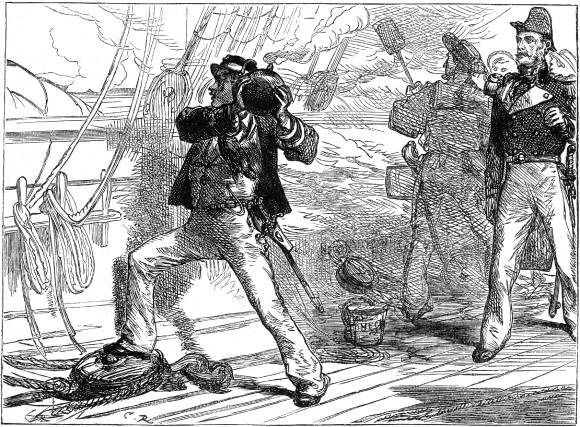
Captain Hall showed his gratitude for the
saving of his ship by promoting Lucas on the spot to Acting Lieutenant. In his
report. Hall was also fulsome in his praise for Lucas’s great presence of mind.
In turn, Sir Charles Napier echoed this praise and recommended confirmation of
Lucas’s promotion.
Hall also exaggerated the damage inflicted
upon the Russians and earned a stiff rebuke from the Admiralty for putting his
ship in unnecessary danger and expending all his ammunition to little effect.
None the less, the news was well received by a British public hungry for some
offensive movement from their much-vaunted navy. For a while, the name Bomarsund was the topic of conversation and a new coal mining village near Newcastle was even named
after this obscure Baltic fortress.
For his bravery in saving the lives of his
fellow crewmen, Charles Lucas was awarded a gold Royal Humane Society Medal.
This large 51mm dia medal was not intended for wearing, but Lucas had a ring
and blue ribbon fitted. In 1869, official permission was granted for the
wearing of the medal and 38mm dia medal was produced with a scroll suspension
and navy blue ribbon.
Just three years later, on 26 June 1857,
Lieutenant Charles Lucas stood fourth in the line of recipients at the first
investiture of the Victoria Cross and received his award from Queen Victoria (see first
edition of The Journal, Oct.2002).
Lucas did not see any further action but
steadily climbed the promotion ladder. He served on Calcutta, Powerful, Cressy, Edinburgh, Liffey and
Indus. In 1862 his was promoted to Commander
and then to Captain in 1867, before retiring on 1 October 1873. He went to live
with his sister and brother-in -law in the Western Highlands until he received a
summons to his death bed from his old captain, now Admiral Sir William Hall KCB, FRS,
who made an extraordinary request. He begged Lucas to take care of his wife
Hilare and to marry his only daughter, Frances. Lucas, an incurable romantic,
agreed. The marriage was not a success for Frances was arrogant and
violent-tempered and far too aware of her position as a member of the Byng
family. being the grand-daughter to the 6th Viscount Torrington. They married in 1879 and produced
three daughters.
They made their home at Great Culverden,
on the Mount Ephraim area of Tunbridge Wells. In 1885, Lucas was promoted to Rear-Admiral on
the retired list. He occupied himself as a JP for both Kent and Argyllshire.
After a train journey, Lucas found to his dismay that he had left all his
medals in the carriage. They were never recovered. Instead, he was issued with
a duplicate group. The IGS bar’Pegu’ is engraved with his details, as are both
gold Royal Humane Medals. The Baltic Medal is blank, as is the reverse of the
Victoria Cross.
Charles Lucas died peacefully at his home
on 7 August 1914, just as Europe plunged into
the madness of the First World War. He was buried in St Lawrence’s Churchyard
at the nearby village
of Mereworth
Lt. George Knowland
The Last Commando VC
By Robert J.Mewett
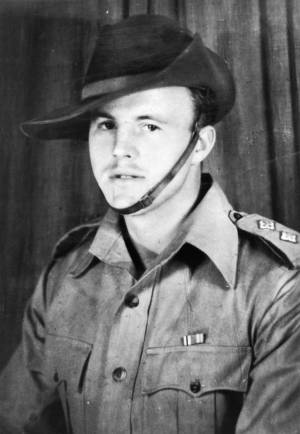
The above portrait * shows a fresh-faced young George Knowland, recently
promoted and proudly displaying his lieutenant’s pips. He wears a jungle
warfare cob hat and on his breast is the ribbon of the newly issued
Defence Medal. Tragically, he would never live to wear the crimson ribbon
of the Victoria Cross.
My late father, Bob Mewett, served with Lieutenant George Knowland during
the epic battle fought on Hill 170 in 1945. It has always been a
fascination to me as to what manner of man he was to perform such a
prolonged act of bravery.
The awarding of the VC from an outsider's point of view seems to be a
controversial affair for who is to say which act is braver than another or
which danger is the greater. It is undoubtedly true that many deserved VCs
have probably not been awarded and many brave acts have gone unnoticed and
unwitnessed. But from the soldier's side things are more straightforward.
Comrades who were there recommend VCs and appreciated the danger. The VC
winner is a soldier’s 'Soldier', the one every raw recruit aspires to when
they first enlist. He stands as their mentor and self image of a supreme
fighting man.
The VC is earned in the soldier’s dream but won in his worst nightmare.
The VC recipient is proudly claimed by his regiment and held up as an
example of what a soldier should be. But this, for those who are
interested in such matters as 'what manner of man' wins a VC, is where
confusion sets in. Many have won the ultimate award and have lived to tell
the tale and on enquiry these recipients have proved to be on the whole
ordinary and self effacing, disarming the questioner with such answers as,
'I only did what anybody would have done' or 'I don't see my self as
brave'. This is the point, for bravery is seen from the perspective of
those around the individual, and is very rarely, conceived by the
individual themselves.
Those who do survive seem to spend their future time eroding the event to
a more manageable size, rubbing the edges off and smoothing things over,
in order for them to shoulder the burden of this the highest of battle
field awards.
Strangely, living VC winners do not seem to be the place to look for the
answer of 'What Manner of Man?'
The pressures of winning such an award do not burden those who are awarded
the VC posthumously. We only left with a citation. An individual and an
action frozen in time and space never to be changed, just read and
interpreted by any one interested enough to want to.
A photo often accompanies citations. Only those few that don't carry an
image are the individuals condemned to remain invisible heroes. But some
citations border on the mundane and again unintentionally reduce the act
to almost everyday.
It seems to depend on how long after the action the citation is written
and how close the writer was to the original deed and their creative skill
in reproducing the facts. If you can have luck in such things we have it
in the highly detailed citation to Lt George Knowland.
EARLY YEARS
George Arthur Knowland was born in Catford in South East
London on 16 August 1922 and, after the death of his mother, he spent some
time in care at an orphanage. In the 1930s, he lived with his father in
Greenfield Road, Croydon and attended the local school, Elmwood Junior
School. As soon as he was old enough, he enlisted in the army in 1940 and
joined the Royal Norfolk's, later volunteering for the Commandos.
He was posted to No3 Commando and fought with them in Sicily and Italy.
Distinguishing himself in this theatre, he was promoted to sergeant. When
he returned home for officer training, he married Ruby Weston. In January
1945, he was sent out to the Far East to join No I Commando, which was now
resident in Myebon, Burma.
No 1 Commando had fought in North Africa on the Torch Landings and had
spent months of hard training in India preparing for the assault of the
Arakan Peninsular. George Knowland, now commissioned lieutenant, was
posted to 4 Troop as a section leader.
3 Commando Brigade, of which No.1 Army Commando were a part along with
No.5 Army Commando and 44 and 42 RM Commando, were given the task of
assaulting the Arakan Peninsular at Myebon. Here they were to take and
hold the dominant features of the southern Chin Hills. If they could
achieve this, they would cut off the supply and escape routes of the enemy
and secure the bridgehead.

HILL 170
No 1 Commando secured and dug in on a feature known as
Hill 170, code named ‘Brighton’, a half mile from the village of Kangaw,
with 4 Troop defending the most northerly end. It was the start of which
was to become an epic battle lasting 10 days. Finally, the Japanese
commander concentrated his numerically superior force of 300 against Hill
170 and the surviving 24 men of 4 Troop. An estimated 700 shells landed on
the hill on that last day of the battle. In a day of continuous fighting,
much of it hand to hand, the Commandos repulsed and counter-attacked the
waves of fanatical Japanese. Prominent amongst the defenders was the
newcomer, George Knowland, whose energy and bravery acted as an
inspiration to his comrades. This made him a particular target and he drew
heavy incoming fire, but miraculously he was unscathed.
He used just about everything he could lay his hands on the keep the enemy
at bay; grenades, rifle, light machine gun and even a 2 inch mortar, which
he fired from the hip against a tree stump. This use of a mortar was both
difficult and dangerous, as the recoil would have been considerable. At a
moment when the Japanese were only about 10 yards away, Knowland grabbed a
Tommy gun from a casualty and, standing up in full view, sprayed the
attackers until they fell back. At this moment of victory, he was mortally
wounded. The crucial ground, however, was never lost and the critical
position secured until re enforcements arrived.
When 3 Commando Brigade second in command, Brigadier Peter Young, arrived,
he noted, almost the first of our dead I saw was Knowland. He lay on his
back, one knee slightly raised, with a peaceful smiling look on his face,
his head uncovered.
Around the forward positions occupied by 4 Troop lay 340 enemy dead and a
further 2300 dead around the whole of Hill 170.
Citation in respect of VC award to Lt G.A. Knowland
War Office – 12 April 1945
The KING has been graciously pleased to approve the posthumous award of
the VICTORIA CROSS to: -
Lieutenant George Arthur KNOWLAND (323566), The Royal Norfolk Regiment
(attached Commandos) (London S.E.1)
In Burma on January 31, 1945, near Kangaw, Lieutenant Knowland was
commanding the forward platoon of a troop positioned on the extreme north
of a hill, which was subject to very heavy and repeated enemy attacks
throughout the whole day. Before the first attack started Lt Knowland’s
platoon were heavily mortared and machine gunned, yet he moved about among
his men keeping them alert and encouraging them, though under fire himself
at the time.
When the enemy, some 300 strong in all, made their first assault they
concentrated their efforts on his platoon of twenty four men, but in spite
of the ferocity of the attack, he moved about from trench to trench
distributing ammunition, and firing his rifle and throwing grenades at the
enemy, often from completely exposed positions.
Later when the crew of one of his forward Bren guns had all been wounded,
he sent back to troop HQ for another crew and ran forward to man the gun
himself until the crew arrived.
The enemy was less than ten yards away from him in dead ground down the
hill, so, in order to get a better field of fire, he stood on top of the
trench firing the light machine gun from the hip and successfully kept
them at a distance until a medical orderly had dressed the wounded men
behind him.
The new Bren team became casualties on the way up, and Lt Knowland
continued to fire the gun until another team arrived.
Later when a fresh attack came in he took over a 2inch mortar whose team
had been ordered to the forward trenches to replace casualties, and in
spite of heavy fire and the closeness of the enemy he stood up firing the
weapon from the hip and killing six of the enemy with his first bomb. When
all bombs were expended he went back through heavy grenade mortar and
machine gun fire to get more, which he fired in the same way in front of
his platoon in the open. When those bombs were finished he went back to
his own trench and continued to fire his rifle at the enemy. Being hard
pressed and with the enemy closing in on him from only 10 yards away he
had no time to recharge his magazine. Snatching up a Tommy gun of a
casualty he sprayed the enemy and was mortally wounded stemming this
assault, though not before he had killed and wounded many of the enemy.
Such was the inspiration of his magnificent heroism, that, though fourteen
out of twenty four of his platoon became casualties at an early stage, and
six of his positions were over¬run by the enemy, his men held on through
twelve hours of continuous and fierce fighting until reinforcements
arrived. If this northern end of the hill had fallen, the rest of the
position would have been endangered, the beach head dominated by the enemy
and other units inland cut off from supplies.
Not suprisingly, No.1 Commando was honoured with many gallantry awards, of
which Knowland’s was the highest. In addition, there were 2 MCs, 2 DCMs
and 13 MMs.
Knowland’s VC was received by his widow, Ruby, who handed it on to his
father, now a publican. For many years it was proudly displayed in his
Finsbury pub but, in 1958, it was stolen and has never been seen again.
George Knowland’s body was buried at Taukkyan War Cemetery, 20 miles north
of Rangoon. On 9 May 1995, a brass plaque was unveiled by the late Captain
Philip Gardner VC to the eight VC recipients, including Knowland, from the
London Borough of Lewisham.
On 31 January 2002, George Knowland was further honoured by his old school
in Croydon. Through the efforts of Michael Lyons of the British Legion, a
handsome plaque has been placed in the hall at Elmwood Junior School and
was unveiled by Countess Mountbatten.
Subsequently, the Commando Association contacted the school's head
teacher, Heather Jones, and together formulated an annual award to be
given on 31 January, to mark the anniversary of Knowland’s death.
The George Knowland Certificate of Merit will now be presented to the
Elmwood pupil who exhibits the lieutenant’s example of selflessness.
Editor’s note)
ACKNOWLEDGEMENTS
Harry Winch (2 Troop), John Huntington (3 Troop), Charles Hayes, Vic
Ralph, the late Bob Mewett (4 Troop), Henry Brown MBE, ORSM…all veterans
of Hill 170. They also served: John Lowman (4 Troop),
Pete Dovey & Roy Nicholls (5 Troop)
* Photo portrait reproduced with kind permission of the Imperial War
Museum, ref. HU2031
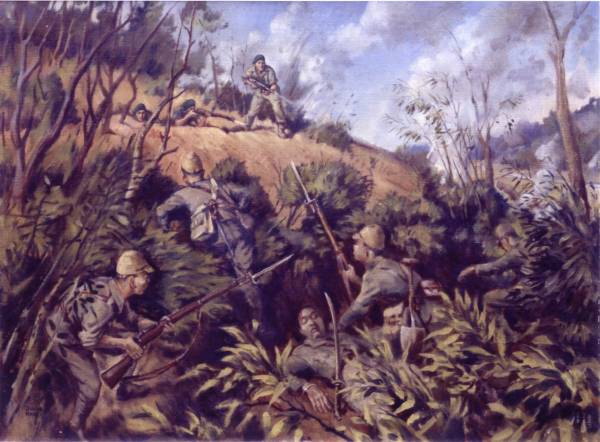
Artist’s impression of Lt. George Knowland defending
Hill 170, with kind permission from the 1st Battalion the Anglian Regt.
THE UNVEILING AND DEDICATION OF THE VICTORIA CROSS AND GEORGE CROSS
MEMORIAL, WESTMINSTER ABBEY, 14 MAY 2003
by John Mulholland
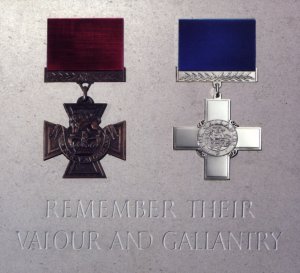
On 14 May 2003, HM The Queen paid special tribute, on behalf of the
nation, to recipients of the VC and GC when she unveiled the first
national memorial at Westminster Abbey. The decision to place the memorial
stone in the Abbey followed an eight-year campaign by the VC and GC
Association. Although there are many memorials to individuals and groups
of VC and GC recipients, until now there had been no national memorial to
honour them collectively. The memorial ledger is engraved in nabresina
stone, with enlarged bronze and silver crosses, inlaid with enamel
ribbons. Beneath is the simple inscription: "REMEMBER THEIR VALOUR AND
GALLANTRY."
The Queen was accompanied by HRH The Duke of Edinburgh and the service was
attended by over 1,600 guests including 11 of the surviving 15 VC holders
and 23 of the surviving 29 GC holders. The recipients attending the
service travelled from Britain, Australia, New Zealand, Canada, India,
Malaysia, South Africa and the USA.
Guests began arriving at the Abbey from 9.00 am onwards and there was
strict security with armed police manning the security booths at each
entrance. By 10.00 am there was a large traffic jam outside the Abbey as
roads nearby were cordoned off. Outside the Great West Door there was a
tri-service guard of honour and inside an array of flags of nations
representing recipients of the VC and GC. The Queen and The Duke of
Edinburgh were received at the Great West Door by the Very Reverend Dr
Wesley Carr, Dean of Westminster, the Archbishop of Canterbury and Sir
Tasker Watkins VC GBE DL, Deputy President of the VC and GC Association.
The service began at 11.00 am with Fanfare for a Ceremonial Occasion
played by the Fanfare Trumpeters of the Royal Marines. During the opening
hymn, The Queen and the Duke of Edinburgh took their places. The bidding
was made by the Dean, followed by prayers and the first reading from
Romans 12:1-9 by Lt. Cdr Ian Fraser VC DSC RD*, Vice-Chairman of the VC
and GC Association. The Choir then sang Psalm 67.
The next reading from The History of the Peloponnesian War by Thucydides
(circa 400 BC) was an inspired choice. It was read by Colonel Stuart
Archer GC OBE ERD, Chairman of the VC and GC Association. The passage from
Pericles' Oration over the Athenian Dead, included the lines: "No, they
joyfully determined to accept the risk. Thus choosing to die resisting,
rather than live submitting, they fled only from dishonour, but met danger
face to face, and after one brief moment, while at the summit of their
fortune, escaped, not from their fear, but from their glory."
Colonel Archer then invited The Queen to unveil the Memorial, which was
placed on a specially designed stand and covered with the Union Flag.
After the unveiling the Queen said: "Mr Dean, to remember the valour and
gallantry of all holders, living and departed, of the Victoria Cross and
George Cross, I ask you to receive this memorial into the custody of the
Dean and Chapter, and invite you to dedicate it." Following the dedication
the congregation stood for the stirring Antiphon which was specially
commissioned for the service.
The Archbishop of Canterbury, Dr Rowan Williams, then delivered a sermon
and argued that bravery was not simply a wild disregard for danger. "The
conduct of war relies on many kinds of bravery… and often behaviour in war
or in crisis is so mixed that it is hard to tease out real virtue from the
courage of temperament or madness", the Archbishop said. But there was
more to bravery than heroic insanity: "Courage of heart and mind comes not
just from patriotism, but from conviction that a country is committed to
justice and freedom; not just from obedience to orders or to some abstract
duty, but from a sense of the human worthwhileness of comrades and
colleagues and, simply, other human beings." The Archbishop concluded that
the type of courage displayed by the holders of the VC and GC was of a
selfless nature: "Courage as a true virtue is the kind of courage that
reflects the bravery of Christ, courage that does not deny the reality of
fear but is moved and energised by a vision," he said. "It is always
courage that is exercised in one way or another for the sake of others, to
make something possible for others, not for personal gain or glory."
A soldier, sailor, airman and a policeman then carried the newly dedicated
memorial to its site close to the Tomb of the Unknown Warrior. The party
was preceded by the flags of the representative nations and four holders
of the George Cross: Michael Pratt, Alf Lowe, Tony Gledhill and Derek
Kinne. Four holders of the VC immediately followed the memorial: Lt Cdr
Ian Fraser, Keith Payne, Flt. Lt. John Cruickshank and Capt. Rambahadur
Limbu. At the rear were the Verger, the High Commissioner for Malta, the
Dean's Verger and the Dean. Whilst this procession slowly moved down the
nave, the choir sang an anthem from The Pilgrim's Progress by John Bunyan.
The congregation stood and faced west for the Act of Remembrance and the
notes of the Last Post resounded around the Abbey. The Last Post caused
some, in an otherwise stoical congregation, to dab their eyes in memory of
departed relatives and friends.
The High Commissioner for Malta gave the exhortation to which the
congregation said, "We will remember them". During the silence the stone
was placed close to the Tomb of the Unknown Warrior, near the Great West
Door. After a faultless Reveille, the procession returned to the Quire and
Sacarium whilst the congregation sang He who would valiant be. The prayers
were adapted from a collection selected by the late Rev. Geoffrey Woolley
VC OBE MC. The closing hymn was Now thank we all our God, followed by the
blessing and the National Anthem.
To anyone present it was clear that much thought and preparation had been
given to the service and everything appeared to go to plan. Those in the
congregation had the benefit of video screens to view the proceedings.
Unfortunately, for some, the view was marred by the headress of some
ladies in the congregation - a similar problem was reported by The Times
at the first VC investiture in Hyde Park on 26 June 1857. Also the sound
system in the Abbey had its problems so that in certain parts of the
service, notably the Archbishop's sermon, echoes caused an indistinct
sound. But these problems were minor in comparison to the spectacle of
such a momentous occasion - the most important gathering of VC and GC
holders and relatives since the 1956 VC centenary celebrations in London.
Each member of the congregation received an Order of Service and a
memorial booklet, which listed all recipients of the VC and GC and a list
of donors to the memorial. At the end of the service most of the
congregation filed past the memorial and left by the Great West Door.
After the service many of the guests attended a reception at Westminster
Hall. They walked past the North Door of the Abbey on a cordoned off
pavement on Broad Sanctuary. The traffic was diverted around Parliament
Square because Margaret Street (opposite the Palace of Westminster) was
shut to traffic to allow the guests across the road to Westminster Hall.
Many guests were in uniforms or suits wearing their full size medals. Some
guests wore their relatives' VC groups or miniatures on their right
breasts. Members of the general public were cordoned off behind barriers
at either end of Margaret Street and a large police presence ushered
guests towards the security gates where invitation tickets were shown to
gain access to Westminster Hall.
Not all those who had received invitations to the service received
invitations to the reception in Westminster Hall. Each VC or GC holder was
accompanied by up to three guests and deceased VC and GC recipients were
also represented by up to three guests. There were a number of other
invited guests, politicians and VIPs. Once inside the gates of the
precincts of Westminster Hall there was a relative calm and the guests
formed an orderly queue to enter.
The Queen arrived at Westminster Hall in her maroon Daimler which first
saw service in 2002 for her Golden Jubilee celebrations. The Lord Great
Chamberlain, the Marquess of Cholmondeley and Colonel Stuart Archer,
received her Majesty.
Once in the Hall there was a great crush of people and it was difficult to
move about. An army of white-clad waiters and waitresses provided a
constant supply of food and beverages. The walls were decked with large
murals of the VC and GC. The Hall is a rather dark and forbidding place
with little natural light. Even with artificial light it had a gloomy
appearance. Apart from its size, it is because of the Hall's sombre nature
that it has been used on so many lying-in-state occasions.
The Queen, Patron of the VC and GC Association, received applause as she
walked down a red carpet and was presented to a number of special guests
by Mrs Didy Grahame MVO, Secretary of the VC and GC Association. The
proceedings in the Hall were informal. There were no speeches or programme
and just one short announcement. A number of the elderly or infirm VC and
GC holders took to seats and were surrounded by friends and well wishers.
On the stage at the back of the Hall the orchestra of the Irish Guards
played popular melodies but at the beginning of the reception their notes
were drowned out by the conversation of the guests. Official photographers
in smart suits moved about the Hall doing their work. At about 2.30 pm
coaches arrived for some guests and the Hall began to empty and by 3.00 pm
the reception was over.
The Guardian of 15 May 2003 reported the evaluation of one VC holder and
one GC holder. John Cruickshank VC said of the memorial: "It is
magnificent, but it could have been done before now." But Alf Lowe GC
said, "I think the reason there's been no memorial before is because the
majority of us would not have initiated it ourselves. We're rather
reticent." An Australian newspaper recorded the comment of Mr Keith Payne
VC, a Vietnam veteran who said: "It's a little overdue but it's an
appropriate time with the world situation so uncertain at the moment".
The Daily Mail reported that for two women, it was a particularly poignant
occasion. Mrs Sara Jones, widow of the late Colonel 'H' (Herbert) Jones VC
said: "It would have been H's birthday today. He'd have been 63 so it's
good timing and it's been a wonderful day."
As the mother of the late Sergeant Ian McKay VC, Mrs Freda McKay also felt
deeply moved: "I must be the only VC's mother here and I have met some
lovely people." Both women were a present reminder of the exacting toll of
war and the fact that many of the VC and GCs were awarded posthumously.
This thought was echoed during the Service in the final words of the
reading from Thucydides:
"For this offering of their lives, made in common by them all, they each
of them, individually received that renown which never grows old, and for
a sepulchre, not so much that in which their bones have been deposited,
but that noblest of shrines wherein their glory is laid up to be eternally
remembered upon every occasion on which deed or story shall call for its
commemoration. For heroes have the whole earth for their tomb."
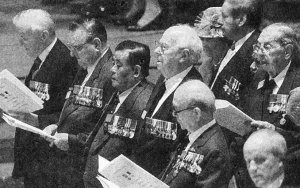
The VC holders present were:
Capt Richard Annand
Flt Lt John Cruickshank
Lt. Cdr Ian Fraser
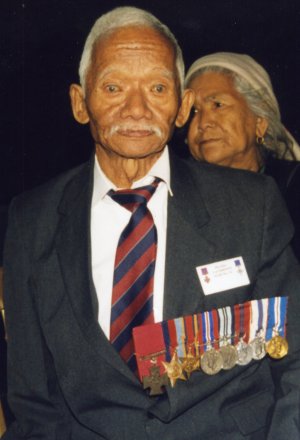
Havildar Lachhiman Gurung (Pictured)
Capt Rambahadur Limbu
Mr Keith Payne
Sub Major Umrao Singh
Mr Ernest Smith
Mr William Speakman
Sir Tasker Watkins
Lt Col Eric Wilson
Total: 11 out of 15 living recipients
The VC holders unable to attend were Bhanbhagta Gurung, Edward Kenna,
Gerard Norton and Tulbahadur Pun.
The GC holders present were:
Col Stuart Archer
Mr John Bamford
Mr James Beaton
Lt Cdr John Bridge
Lt. Col. Arthur Butson
Mr Harry Errington
Mr Kenneth Farrow
Mr Harwood Flintoff
Mr Anthony Gledhill
Mr John Gregson
Mr Derek Kinne
Mr Alfred Lowe
Mr Joseph Lynch
Mr Frank Naughton
Mr Michael Pratt
Mrs Margaret Purves
Mr Awang anak Raweng
Mr Geoffrey Riley
Mr Henry Stevens
Lt Col George Styles
Mr Charles Walker
Mr Eric Walton
Mr Charles Wilcox
Total: 23 out of 29 living recipients
The Times of 15 May lists Mr Carl Walker GC as attending, but the VC & GC
Association confirmed that he was unable to attend at the last minute
The Island of Malta and the Royal Ulster Constabulary also received the
GC. Dr. L. Gonzi, the Deputy Prime Minister of Malta and Mr Jim McDonald,
Chairman of the Royal Ulster Constabulary GC Foundation represented them
at the Service.
The above list of those attending was taken from The Times, 15 May 2003.
Acknowledgements
Order of Service Programme - Westminster Abbey, 14 May 2003
The Daily Telegraph, 15 May 2003
The Guardian, 15 May 2003
The Times, 13 and 15 May 2003
The Daily Mail, 15 May 2003
The Evening Standard, 14 May 2003
Terry Hissey and Derek Hunt for their contributions and helpful comments
Rebecca Lee for drafting assistance
Memorial Video and Booklet
The video of the service and reception is available at £12 per copy and
the VC and GC Memorial Booklet is available at £2.50 per copy from The VC
and GC Association, Horse Guards, Whitehall, London SW1A 2AX. Tel 020 7930
3506 Fax 020 7930 4303.
THE
TRUE STORY OF JAMES GORMAN VC
by
Harry Willey, New South
Wales, Australia
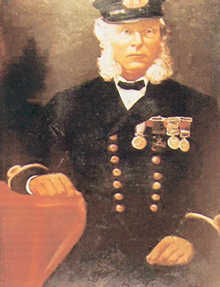
Captain of the
Afterguard JAMES GORMAN VC.
Second Mate, NSS VERNON
This
Portrait was presented to James Gorman VC.
on his leaving the NSS
"Vernon" by the boys of the ship as a token of their regard
Artist
unknown; Photo by Harry Willey.
Original portrait donated by Marjorie
Willey
to Naval Collection, Spectacle Island
INTRODUCTION
I first became interested in
the Crimean War Victoria Cross recipient, James Gorman, when I was shown a
portrait of him by my future father-in-law, who had been married to one of
Gorman's six grand-daughters. The family, who owned the VC medal group,
were justly proud of their ancestor and believed he had been awarded his
Cross for saving the life of Captain Lushington at the Battle of
Inkermann.
Subsequent investigation threw up a mystery in the form
of another James Gorman, who had changed his name from Devereaux when
joining the Royal Navy. This Gorman/Devereaux had been born in Suffolk in
1819, whereas the true James Gorman had been born on 21 August 1834 in
Islington. The latter joined the Navy in 1850 and was serving on HMS
Albion at the outbreak of the Crimean War. It is probable that
Gorman/Devereaux was a rating on the Beagle when the call came for
the Navy to supply a Brigade to help in the bombardment of Sebastopol.
On 26 October 1854, the day after the ill-fated Charge of the
Light Brigade at Balaclava, a strong Russian force attacked the right
flank of the British siege position before Sebastopol. Disregarding an
order to spike his gun, Acting Mate William Hewett and three naval
gunners, including Gorman/Devereaux, kept such a rate of fire at close
range, that the Russians were forced to withdraw. For his steadiness in
the face of the enemy, Hewett was awarded the Victoria Cross.
It
was for this action that the bogus James Gorman claimed to have also been
awarded the Victoria Cross and many have genuinely believed his was
entitled to such an award. After all, he had faced the same danger as
Hewett and received nothing. Whatever his grievance, he was not entitled
to the Victoria Cross and, whether deliberately or through a
misunderstanding, he managed to convince enough people of this claim that
successive reference works accept him to be the rightful James Gorman.
One of the reasons the bogus Gorman was not exposed was that the
true recipient had made his home on the other side of the world,
Australia.
With the help of friends who researched the primary
sources in England, and my own research of the well-recorded life and
death of James Gorman VC, following his emigration to Australia in 1863, I
have been able to write the following story.
His Life in the
Navy
Captain of the Afterguard, JAMES GORMAN VC was born in
Islington, Middlesex, on 21 August 1834 to Patrick James Gorman, a
nurseryman, and his wife Ann (nee Furlong). They had been married at the
famous St. Martin's in the Field Church, Westminster, on the 23rd of
November 1829. When he reached the age of thirteen, James was one of the
first group of two hundred boys to be accepted into the Royal Navy as
apprentices.
He entered HMS Victory as a boy second class
on 2 March 1848. The old 2164 ton Victory had been Nelson's
flagship at the Battle of Trafalgar but, with the advent of steam, he had
been relegated to a training ship thus avoiding the fate of most of the
obsolete sailing warships, which were used as prison hulks, floating
stores or just broken up.
At the completion of six months'
training on board the HMS Victory, Gorman was transferred with
sixty-one other apprentices to HMS Rolla, a paddle wheel and sail
tender to Victory. She was a "Cherokee" Class 10 gun brig
sloop of 231 ton that had been completed in 1829 in Plymouth Dockyard. The
Apprentices cruised the choppy waters of the Channel on the Rolla
until they were declared fit to go to sea.
Gorman gained
recognition as a good seaman and was kept beyond his allotted time on
HMS Rolla to work as an Instructor for the second intake of
apprentices. At the completion of his duty on HMS Rolla he was
transferred to Dragon for only a short period from 13 September
1849 till 1 November 1849, before he was transferred to Howe where he
stayed until 12 July 1850.
He then transferred from Queen
(a floating barracks) to HMS Albion, his first ship as a boy first
class on 13 July 1850. Records show that at that time he was 5ft 2in
(155cm) tall, with blue eyes, had light brown hair and a ruddy complexion.
It was also noted that he had been vaccinated against smallpox.
James was promoted to Ordinary Seaman 2nd Class on 13 May 1852,
then further promoted to Able Seaman two months later. During the Crimean
War, he was a member of The Naval Brigade from the 1st October 1854 to 9
September 1855.
The Naval Brigade consisted of 1020 officers and
men from HMS Albion, Britannia, Bellerophon, Diamond, London, Queen,
Rodney, Trafalgar and Vengeance, who were under the Command of
Captain Stephen Lushington of the Albion.
The Naval Brigade
had been formed at the request of Lord Raglan who had asked the Navy for
assistance. At first the sailors only worked around the camps in a
non-combatant role. Then, as more of the soldiers were either killed or
wounded, they were replaced by the sailors.
The Crimean War was
the first time correspondents had been allowed to report first hand from
the battlefield. They sent their eyewitness accounts of the conflict to
the London Newspapers. The reports by William Howard Russell of The
Times were thought to be the most graphic. In describing the Battle of
Inkermann, Russell had quoted Lushington's own words: "It had commenced
at half past seven on a cold misty morning and was a determined attempt by
the Russians to force the British from the heights above the town of
Sebastopol. A long day of heavy fighting followed and the Russians were
eventually driven back."
In the Right Lancaster Battery, where
eleven days before Hewett had won his VC, the British were suffering heavy
casualties as the massed grey ranks of Russians advanced up the Careenage
Ravine.
Among the acts of bravery Russell reported was the
determination of five sailors from the Albion. These sailors, when
ordered to withdraw and leave the wounded, were reported to have replied
"They wouldn't trust any Ivan getting within bayonet range of the
wounded". The five sailors then mounted the defence works
(banquette) and kept up a continual and rapid rate of firing which
drove the enemy back three times. They were helped by wounded soldiers who
lay in the trench beneath them, who kept a constant flow of reloaded
rifles for their bluejacket comrades. Because of their exposed position,
the inducted infantrymen came under heavy fire, which swept the top of the
parapet and two of the sailors fell dead. This left the surviving three
sailors, James Gorman, Thomas Reeves and Mark Scholefield, to hold the
Russians at bay. The Russians advanced to within forty yards of the
battery before the steady fire from the naval trio finally caused the
attack to stall and the enemy began to retreat.
On the 7 June 1856
the three surviving sailors, Gorman, Reeves and Scholefield were
recommended by Sir Stephen Lushington to Queen Victoria as being worthy
recipients of the Victoria Cross. On the 24 February 1857 their names
appeared along with the names of 83 others upon whom the Queen had
conferred this honour. The Queen presented his decoration to Thomas Reeves
in Hyde Park, London, on 26 June 1857. On the same day, two Victoria
Crosses were dispatched by the War Office to be presented to Gorman and
Scholefield who were both serving in the China War.
Reeves and
Scholefield had little time to enjoy the fame of their awards; the former
died in 1862 and the latter at sea on 1858.
Gorman's Victoria
Cross was one of fifteen awarded for the Battle of Inkermann. His service
medals at this time were the Crimea Metal with Clasps for Inkermann &
Sebastopol, and the Turkish Crimea Medal, which was presented to him by
the Sultan of Turkey. He subsequently receive the 2nd China Medal with the
Canton 1857 bar.
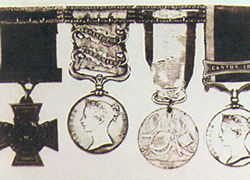
The Metals Awarded to James
Gorman VC
Photo by Harry Willey, c1993
Gorman left
HMS Albion on 5 January 1856 with a "Very Good Conduct" report and
the following day signed on HMS Coquette as an AB. HMS
Coquette was a 670 ton wooden screw steam gun vessel of 200
horsepower, carried 4 guns and had a top speed of 10.8 knots. She had been
built by Green Blackwall on the Thames in 1855.
On 17 March 1856,
Gorman was transferred to Haslar Hospital in Gosport, Hampshire where he
was hospitalised with "rheumatism" for six weeks. When discharged from the
Hospital on 2 May 1856 he returned to HMS Coquette from where he
was discharged from Her Majesties Service three weeks later. For just a
fortnight, Gorman was a civilian ashore, until he re-enlisted for duty on
HMS Elk when the sloop was commissioned at Chatham. HMS Elk
was a brig sloop of 12 guns, having been built at Chatham Dockyard in
1847. She was 105ft long and 482 ton. It was one of the first ships of the
Royal Navy to become part of the Australia Station of the Royal Navy.
It was on 31 March 1857 while serving on HMS Elk that
Gorman received his first payment of the pension of £10 per year that had
been granted to recipients of the Victoria Cross. He received a payment of
£24 and eleven pence, the pension having been back-dated to 5 November
1854. Following this initial payment, Gorman received a quarterly payment
of £2 pounds and ten shillings for the rest of his life.
During
his service on HMS Elk, he took part in operations in the Canton
River at the taking of Fatchan and Canton from 28 December 1857 to 5
January 1858. Promoted to Captain of the Afterguard of the Elk,
James Gorman VC visited Australia on three occasions. Sydney on 31
December 1858 and again in January 1860, also calling at Melbourne in
March 1859. James Gorman VC was Paid Off at Sheerness on 21 August 1860,
his 26th Birthday, at which time he was recorded as having grown 3 inches
to become 5ft 5in (162.5cm) in height.
For the story of his
fascinating life in Australia, read the full account in the Journal of the
Victoria Cross Society
SOUTH
DEVON PAYS TRIBUTE TO TWO VC HEROES
Two
Victoria Cross recipients from the neighbouring riverside communities of
Dartmouth and Kingswear were honoured in two ceremonies that took place,
appropriately, on Remembrance Sunday, 10 November and Armistice Day, 11
November 2002. In what may be a unique event in the recent honouring of
Victoria Cross holders, two such ceremonies were held within 24 hours of
each other in the communities which face each other across the River Dart.
Local
publisher Richard Webb and author Don Collinson discovered that there were
no memorials to Corporal Theodore Veale of Dartmouth or Lt Col H. Jones of
Kingswear.
It was
rather poignant that, in a traditional Royal Navy community, both VCs were
awarded to soldiers, albeit members of the Devonshire - later the
Devonshire and Dorset - Regiment. The next two years were spent
researching, organising and seeking funds for the memorials.
DARTMOUTH
Sir Ray
Tindle, the owner of the Dartmouth Chronicle, as well as a former member
of the Regiment, helped to make the event possible. Similarly, the Jones
family donated funds for the memorial to the Falkland's hero.
Sunday 10
November 2002 was a wet and blustery day that did little to dampen the
spirit of those who witnessed the ceremony in one of Britain's most
picturesque towns. In a moving ceremony at Royal Avenue Gardens, Sir Ray
Tindle paid tribute to Corporal Veale: "Teddy Veale served his country as
did many others in that war in which a million and a quarter British men
and women were lost.
'We
remember them all today, but Teddy Veale risked his life over and over
again to save another. 'His bravery was beyond the call of duty. That is
why we are placing this plaque here in this public place. He will never be
forgotten by his town or his regiment."
Sir Ray
went on to read the citation that appeared in the London Gazette of 9
September 1916:
"For most
conspicuous bravery. Hearing that a wounded officer (Lt.Eric Savill) was
lying out in front, Private Veale went out to search, and found him lying
amidst growing corn within fifty yards of the enemy. He dragged the
officer to a shell hole, returned for water and took it out. Finding that
single-handedly he could not carry the officer, he returned for
assistance, and took out two volunteers. One of the party was killed when
carrying the officer, and heavy fire necessitated leaving the officer in a
shell hole. At dusk, Private Veale went out again with volunteers to bring
in the officer. Whilst doing this an enemy patrol was observed
approaching. Private Veale at once went back and procured a Lewis gun, and
with the fire of the gun he covered the party, and the officer was finally
carried to safety. The courage and determination displayed was of the
highest order."
Mrs
Theodora Grindell, Corporal Veale's daughter watches as Miss Jennifer
Grindell, his granddaughter lays a wreath.
Officers,
men and old comrades of Corporal Veale's regiment then marched to the war
memorial accompanied by the Regimental Band of the Devonshire and Dorsets.
People lined the town's streets before gathering to witness the
traditional wreath-laying ceremony.
Corporal
Veale's daughter, Mrs Theodora Grindell then unveiled the memorial.
Finally, there was a Remembrance service held at St Saviour's Church.
Teddy Veale died a few days short of his 88th birthday on 6 November 1980
and was cremated and his ashes scattered at Enfield Crematorium.
A memorial
to this brave man was long overdue and it was appropriate that his
hometown should honour him.
KINGSWEAR
The
following day, another ceremony took place on the opposite bank at
Kingswear. About 100 onlookers, dignitaries and representatives of the
Parachute Regiment and the Devonshire and Dorset Regiment joined Mrs Sara
Jones and her family in the unveiling of a memorial plaque on the ferry
slipway.
H.Jones's
brother, retired Royal Navy Commander Timothy Jones, delivered a eulogy in
which he preferred not to dwell on his brother's sacrifice, but rather
about his love of Kingswear: "We're not here to remember that bleak
hillside in the Falklands, we're here to remember the man, how much he
loved Kingswear and how much he enjoyed growing up here."
He related
some anecdotes from their childhood, which highlighted the future VC's
sense of daring and adventurous spirit:
"We had a
great childhood and we really enjoyed ourselves, although with the
exuberance of youth we did overdo it sometimes. As growing boys we were a
real trial to our parents and the local bobby, PC Bailey. But life was
always exciting when H was around."
On 11
October 1982, the London Gazette published the following citation: On 28
May 1982 Lieutenant Colonel Jones was commanding 2 Battalion The Parachute
Regiment on operations on the Falkland Islands. The Battalion was ordered
to attack enemy positions in and around the settlements of Darwin and
Goose Green.
During the
attack against an enemy who was well dug in with mutually supporting
positions sited in depth, the Battalion was held up just South of Darwin
by a particularly well-prepared and resilient enemy position of at least
eleven trenches on an important ridge. A number of casualties were
received. In order to read the battle fully and to ensure that the
momentum of his attack was not lost, Colonel Jones took forward his
reconnaissance party to the foot of a re-entrant, which a section of his
Battalion had just secured. Despite persistent, heavy and accurate fire
the reconnaissance party gained the top of the re-entrant, at
approximately the same height as the enemy positions. From here Colonel
Jones encouraged the direction of his Battalion mortar fire, in an effort
to neutralise the enemy positions. However, these had been well prepared
and continued to our effective fire onto the Battalion advance, which, by
now held up for over an hour and under increasingly heavy artillery fire,
was in danger of faltering.
In his
effort to gain a good viewpoint, Colonel Jones was now at the very front
of his Battalion. It was clear to him that desperate measures were needed
in order to overcome the enemy position and rekindle the attack, and that
unless these measures were taken promptly the Battalion would sustain
increasing casualties and the attack perhaps even fail. It was time for
personal leadership and action. Colonel Jones immediately seized a
sub-machine gun, and, calling on those around him and with total disregard
for his own safety charged the nearest enemy position. This action exposed
him to fire from a number of trenches. As he charged up a short slope at
the enemy position he was seen to fall and roll backward downhill. He
immediately picked himself up, and again charged the enemy trench, firing
his sub-machine gun and seemingly oblivious to the intense fire directed
at him. He was hit by fire from another trench, which he outflanked, and
fell dying only a few feet from the enemy he had assaulted. A short time
later a company of the Battalion attacked the enemy who quickly
surrendered. The devastating display of courage by Colonel Jones had
completely undermined their will to fight further.
Thereafter,
the momentum of the attack was rapidly regained, Darwin and Goose Green
were liberated, and the Battalion released the local inhabitants unharmed
and forced the surrender of some 1200 of the enemy.
The
achievement of 2 Battalion The Parachute Regiment at Darwin and Goose
Green set the tone for the subsequent land victory on the Falklands. They
achieved such a moral superiority over the enemy in this first battle
that, despite the advantages of numbers and selection of battle-ground,
they never thereafter doubted either the superior fighting qualities of
the British troops, or their own inevitable defeat. This was an action of
the utmost gallantry by a Commanding Officer, whose dashing leadership and
courage throughout the battle were an inspiration to all about him.
Mrs Jones
said that the Kingswear tribute meant a great deal to the family as, "Of
all the things that have been done over the years to commemorate my
husband's bravery, this is possibly the most wonderful. There is already a
memorial in the church, but I think this is particularly poignant and will
be a reminder to all of us whenever we board the ferry. This was a part of
the world that my husband loved and he had hoped to retire
here."
(1) Three
Devonians won the Victoria Cross in the First World War, rejoicing in the
names of Veale, Sage and Onions.

The
unveiling of memorial to Col. H. Jones VC by Mrs Sara Jones and Commander
Timothy Jones
|



